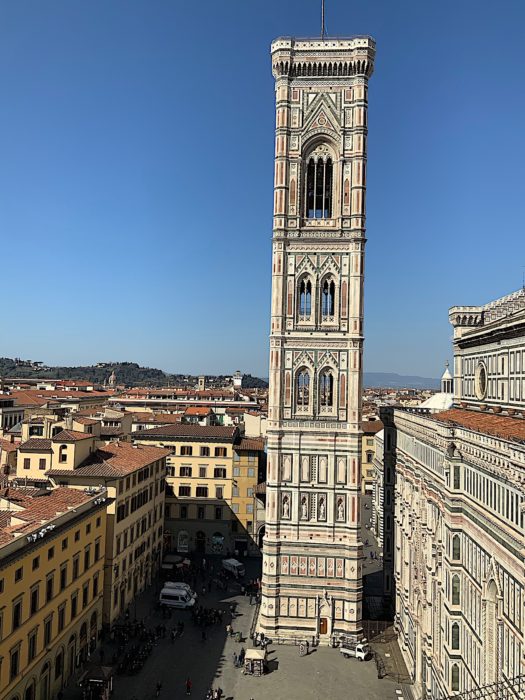
Age
1334-1359
Designers
Arnolfo di Cambio, Giotto di Bondone, Andrea Pisano, Francesco Talenti
The Giotto’s Campanile, located in Piazza del Duomo, is the clearest evidence of Florentine gothic architecture of the fourteenth century. The bell tower is 84.7 metres (277.9 ft) tall and displays polygonal buttresses at each corner. The tower is divided into five stages and houses twelve bells,
of which the five oldest are no longer used; seven bells are used for liturgical service. The bell tower foundations were excavated around 1298, when the master builder was Arnolfo di Cambio. The construction was begun in 1334 by Giotto di Bondone; his design was in harmony with the polychromy of the Cattedrale di Santa Maria del Fiore, as applied by Arnolfo di Cambio. Giotto had time to see realized, before his death (1337), only the base of the bell tower with the geometric patterns of stone external revetment and the bas-reliefs of the hexagonal panels depicting the history of mankind, inspired by Genesis. Giotto was succeeded as master of the works in 1343 by Andrea Pisano who completed the first two floors; Luca della Robbia and Alberto Arnoldi participated in the outdoor decorations. Above the lower level of Giotto, a second fascia, this time decorated with lozenge-shaped panels was added; two more levels, with four niches on each side and each level were built; the first level niches were intended to contain figures of king and sibyls and statues of patriarchs and prophets, the latter later executed also by Nanni di Banco and Donatello; the second row of niches are empty. All the present works of art in the campanile are copies. The originals were removed between 1965 and 1967 and are now on display in the Museo dell’Opera del Duomo. From 1348 to 1350 the works were interrupted and finally were completed in 1359, after the terrible years of the black death, by Francesco Talenti, who built the top three levels, with the large windows and made the panoramic terrace, accessed through approximately 400 steps, that replaced the pyramidal cusp termination in Giotto’s project.
The bell tower is revetted with stone material displaying the typical three colours, the white of the Apuan Marble, the red of the Red Marly Limestone and Red Ammonitic Limestone, and the green of the Serpentinite. The sculptures occupying the sixteen niches are made of Apuan Marble.

